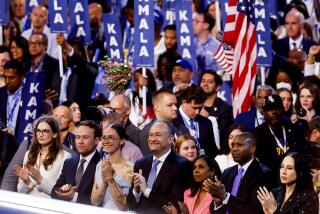UC Berkeley at Crux of New Multiracial Consciousness
BERKELEY â When Cynthia Nakashima came here in 1988 as a graduate student in ethnic studies, eager to explore her experience as the daughter of a Japanese American father and a white mother, there was just one class on the subject of mixed-race descent, the first of its kind in the country.
Pulling together a course reading list was a chore. The research in the UC Berkeley library was piddling and there were no student organizations for the growing number of multiracial young people who wanted to band together and discuss their special concerns.
But with impressive swiftness, the campus has become the epicenter of Americaâs burgeoning biracial baby boom. It is command central for a national movement dedicated to changing the way America measures its racial and ethnic complexity and also the way we think about who we are.
At the heart of this emerging consciousness is the demand that a new âmultiracialâ category be added to the U.S. census in the year 2000 and to all the other forms that classify Americaâs swiftly changing population, which is thought to include 1 million to 2 million people of mixed-race descent.
The federal government, which promises to make a decision on the issue next year, has used the same four racial categories for nearly two decades: American Indian or Alaskan native, Asian or Pacific Islander, black and white. It also asks respondents if they are of Hispanic or non-Hispanic origin.
Federal officials now concede that the system no longer reflects Americaâs diversity. âThe numbers may be precise but theyâre precisely wrong,â said Rep. Thomas C. Sawyer (D-Ohio), who chaired hearings on the subject two years ago.
Nakashima, a PhD candidate who teaches âEthnic Studies 150: People of Mixed-Race Descent,â encourages her students to reject Americaâs black-white, either-or view of race.
âThere isnât anything natural in binary thinking,â she told them last month in her semester-ending lecture. âAmerican culture forces these binaries by offering them. We need to redefine confusion not as a state youâre trying to get out of, but as a natural state when youâre dealing with crazy things. . . . When somebody asks me if Iâm Japanese or white, I answer, âYes.â â
Formally recognizing mixed-race people would open the door to a more flexible mind-set about race. States such as California, where Latino and Asian immigration has already blurred racial and ethnic lines, are particularly ripe for reinterpretation.
Yet the challenge also carries contradictions.
Classifying individuals as âmultiracialâ would trouble many blacks, who believe such a category would drain their ranks and thus their political influence.
And some social observers fear that the new multiracial activists, while preaching inclusion, may be inadvertently creating another set of exclusionary racial membership rules that could further balkanize the state and the nation.
âThey stand a chance of blowing the traditional racial categories to smithereens,â said Todd Gitlin, a professor at New York University and the author of âThe Twilight of Common Dreams: Why America Is Wracked by Cultural Wars.â âBut they could become a tribe themselves and become captivated by exactly what they oppose.â
On the Cutting Edge
Ideally, people of mixed racial descent can be the bridge builders, the cultural brokers, said ex-Berkeley professor Terry Wilson, part Potawatami Indian and part white, and the originator of the first university course on multiracial Americans.
âThose of us of mixed racial descent embody the cutting edge of race relations,â said Wilson, who taught his course from 1977-93, then turned it over to Nakashima, his protege. âWeâre living reminders that the lines are there but the lines get crossed all the time.â
By crossing the lines, mixed-race people have no choice but to grapple with this knottiest of issues from early childhood. And a special perspective develops from challenging stereotypes: the realization that the conventional categories are both contradictory and overlapping, that mom is mom and dad is dad and that race is not the most significant thing about the parentsâ differences.
Take Karla Stine, the daughter of a Japanese mother and a father of black and white ancestry, whose life has been a struggle to pick at the Gordian knot of race relations.
Although Stine grew up watching Japanese television and eating Japanese food, she was unwelcome at cherry blossom festivals and teenage basketball leagues because she looked African American, not Asian. And her father, who looks more white than black, is inexplicably listed as one race on her birth certificate and another on her brotherâs certificate.
âLook at my family and try to figure out where to put us,â said Stine, a Los Angeles native, as she took a break from studying for exams. âWe have to change our way of identifying people. Itâs old. Itâs outdated. It doesnât work.â
Not as Others See Her
Or Nicole Giusti, an English major of black and white descent.
âIâm perceived as black because of the way I look and in some cases I feel black, like when a salespersonâs on my tail in a store afraid that Iâm lifting something,â she said. âBut my parents split when I was 2 1/2 and I grew up with the white side of the family and there I considered myself white.â
What Giusti considered herself was not always what the world considered her.
At a restaurant with her white relatives, the young woman could hear people at neighboring tables wonder aloud if she were adopted. When she took her little cousins to see âToy Storyâ during Thanksgiving break, others in the theater assumed she was the baby-sitter.
âWe have this neurotic need to have stuff in certain places,â Giusti said. âLet it go. Let things be where they will.â
Author Gitlin is quick to call the new multiracial consciousness a âmovementâ and notes that it is âstriking how quickly it has materialized.â
The movement began with the 1967 Supreme Court ruling that legalized interracial marriage. It was fueled by the influx of Latino and Asian immigrants who donât fit easily into a binary formulation of race. And it vaulted to public consciousness with the recent bid to put a multiracial category on the 2000 census.
The â67 high court ruling spawned a sharp increase in interracial marriage and childbirth. Interracial marriage rates have doubled each decade since 1970, from 310,000 mixed marriages that year to 1.2 million in 1992. The number of interracial children has grown accordingly: from 31,200 born in 1968 to four times that number, 128,000, in 1991. Experts estimate that perhaps one-quarter of all multiracial Americans live in California.
Professor Wilsonâs Berkeley class, which gave academic voice to these stirrings, began as a seminar for two dozen ethnic studies students and mushroomed into a lecture for 200, with a waiting list twice that size. Today, mixed-race Berkeley students devour and contribute to a new body of academic research, read new magazines like âInterraceâ and visit specialized Internet sites.
As academic interest flourished, so did grass-roots organizations, dedicated originally to the needs of parents raising mixed-race children. The first of them, I-Pride in Berkeley, formed in 1979 and was followed in the next 15 years by similar groups in Chicago, Washington and Los Angeles, which came late to the game with a family organization in 1987 and a course at UCLA two years later.
These local organizations ultimately coalesced into two national lobbying groups: the Assn. for Multi-Ethnic Americans, which last month won a seat on the committee studying the census categories for the year 2000, and Project RACE, which has successfully pushed seven states (Ohio, Illinois, Georgia, Michigan, Indiana, North Carolina and Florida) to include a multiracial category on all school forms.
The two groups have jointly submitted a proposal for a multiracial category to the Office of Management and Budget, the federal agency responsible for the classification system for race and ethnicity. Those categories have shifted at intervals since the Colonial Period, but since 1977 have been dictated by the OMBâs Statistical Directive 15.
The categories enshrined in Directive 15 are used on forms for not only the census, but for schools, jobs, scholarships, loans and mortgages. The data derived is not neutral in nature, but rather political, driving how the nation defines itself racially and how it assigns electoral power and money.
Inadequate as the current categories may be, they cannot be scrapped willy-nilly. Rep. Sawyer acknowledges that there is a âvery substantial tensionâ between the emerging claim of mixed-race people to define their own identity and the governmentâs need to gather racial and ethnic information in a precise and consistent way, in large part because it feeds the machinery of civil rights.
The two national lobbying groups, the Assn. for Multi-Ethnic Americans and Project RACE, have urged OMB to include a box on the new forms for people of multiracial descent and then ask them, under that umbrella category, to indicate their various races and ethnicities. This dual approach is designed to mollify minority communities, especially some African Americans.
According to various estimates, 75% of the people who check âblackâ on the census form are actually mixed. It is impossible to determine how many of those who identify as black would switch allegiance to a multiracial category, but even a modest defection could have significant effects on legislative districts, desegregation plans, civil rights enforcement and affirmative action programs. Neither the NAACP nor the Urban League responded to repeated telephone calls seeking their position on new census categories. But leaders of the multiracial movement and others say that many officials in the two groups are staunchly opposed to change.
Orlando Patterson, a sociology professor at Harvard, laments any opposition to mixed-race identity. âIf your objective is integration,â said Patterson, who is black and has two mixed-race children, âmixing is the best thing that could happen because by means of such a middle group people feel an investment in both sides.â
That is the case with Pat Sekaquaptewa, a recent graduate of Berkeleyâs Boalt Hall Law School, who is part white, part Hopi Indian and married to an African American man.
âI can see my Hopi side and my non-Hopi side,â she said. âI can see when one is full of bull and when one has hit on something the other hasnât hit on. I had to argue with both sides all the way up: About what they value and why and what doesnât make sense. And this ability to empathize, I didnât have a choice, I just did it. Because the one thing Iâve always known and never needed to be taught is that truth is relative.â
Todayâs mixed-race young people, mindful that the rules of classification change with changing times, are unashamed at using them to best advantage.
Instructor Nakashima checked âAsianâ on her college applications in the early 1980s because she believed it would improve her chances of getting in. Yet five years later, her brother checked âwhiteâ because the political tides in California had turned against affirmative action.
Sekaquaptewa was unequivocal when asked what advice she would give the children that she and her husband hope to have.
âIâd tell them to pick whichever box will get them what they need,â she said. âItâs all political, the way the game is played. But Iâd also educate them that thatâs only a strategy, and how they define themselves is a totally different issue.â
More to Read
Sign up for Essential California
The most important California stories and recommendations in your inbox every morning.
You may occasionally receive promotional content from the Los Angeles Times.










